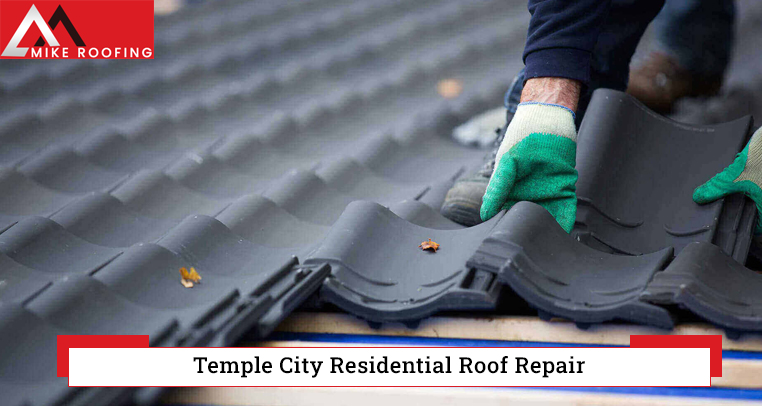Temple City residential roof repair helps you to address a host of issues, including:

Roof leaks can occur due to damaged or missing shingles, flashing problems, or compromised roof valleys. Repairing these leaks is crucial to prevent further water damage to the interior of the home.
Shingles can become damaged or deteriorate due to weather exposure, age, or improper installation. Repairing or replacing these damaged shingles ensures the integrity of the roof and protects against leaks and further damage
Flashing is used to seal roof transitions and prevent water intrusion. If the flashing is damaged, corroded, or improperly installed, it can lead to leaks. Repairing or replacing flashing is essential to maintain a watertight roof.
Over time, the roof structure may weaken or sag, potentially compromising the entire roofing system. Repairing and reinforcing the roof structure ensures its stability and prevents further damage.
Inadequate ventilation can lead to moisture build-up, mold growth, and energy inefficiency. Repairing or improving ventilation systems helps maintain a healthy and energy-efficient environment.
Here are some of the different methods used in Temple City residential roof repair
| Method | Description |
|---|---|
| Shingle Repair | This method involves repairing damaged or deteriorated to ensure a secure and watertight roof surface |
| Flashing Repair | Repairing or replacing damaged or deteriorated flashing around roof transitions to prevent water intrusion and maintain the integrity of the roof. |
| Roof Patching | Patching involves repairing localized areas of damage, such as small leaks or punctures, using suitable materials to restore the roof’s integrity |
| Sealant Application | Applying sealant to areas where leaks or cracks are present, such as around vents or chimneys, to prevent water infiltration and improve waterproofing. |
| Roof Coating | Applying a protective coating on the roof surface to enhance its durability, weather resistance, and extend its lifespan |
| Gutter Repair | Repairing or replacing damaged or clogged gutters to ensure proper water drainage and prevent water damage to the roof and the home’s foundation. |
Roof patching is commonly used for Temple City Commercial Roof Repair. This method is used to repair localized damage or leaks on a roof. The specific method for roof patching can vary depending on the type of roof and the extent of the damage, but the general process involves the following steps:

Inspect the roof to locate the damaged or leaking area that requires patching.
Clear the damaged area of any debris, dirt, or loose materials. This ensures proper adhesion of the patching material.
Use an appropriate roofing patching material, such as roofing cement or roofing tape, to cover the damaged area. Apply the patch material according to the manufacturer’s instructions, ensuring complete coverage and sealing of the damaged area
Press the patch material firmly onto the damaged area to create a secure bond. Use a hand roller or other suitable tool to smooth out any wrinkles or air bubbles and ensure a tight seal.
Depending on the type of patching material used, allow sufficient time for it to cure or dry as per the manufacturer’s recommendations. This ensures the patch material effectively seals the damaged area.
This is another common task for Temple City Residential Roof Repair. Resealing a roof typically involves the application of a new layer of sealant or coating to enhance its waterproofing properties and extend its lifespan. Schedule an appointment with our experienced roofing contractors to get the work done.
Here are the steps involved
Remove any dirt, debris, or loose materials from the roof surface. This ensures proper adhesion of the new sealant and improves its effectiveness.
Thoroughly inspect the roof for any signs of damage, such as cracks, gaps, or deteriorated areas. Address any underlying issues before proceeding with the resealing process.
Follow the manufacturer’s instructions to prepare the sealant or coating material. This may involve mixing, stirring, or dilution, depending on the specific product.
Using a brush, roller, or spray equipment, apply the sealant evenly over the entire roof surface. Pay extra attention to areas prone to leaks or damage, such as seams, joints, and flashing.
Ensure that the sealant is applied in a sufficient thickness to create a durable and effective barrier against water and other elements. Follow the recommended application rate and coverage guidelines provided by the manufacturer.
Give the sealant ample time to dry and cure, as specified by the manufacturer. This ensures proper bonding and sealing of the roof surface.
Once the sealant has fully cured, inspect the roof to ensure that the resealing process has been successful. Check for any missed spots or areas that may require touch-ups.
In many cases, roof leaks can be repaired without replacing the entire roof. Our team can assess the source of the leak and perform targeted repairs to address the issue.
It depends on your specific insurance policy. Some policies may cover roof repairs for damage caused by covered perils, such as storms or falling trees. Review your policy and consult with your insurance provider to understand your coverage.
Look for signs such as leaks, water stains on ceilings, missing or damaged shingles, curling or buckling shingles, algae or moss growth, and excessive granule loss.